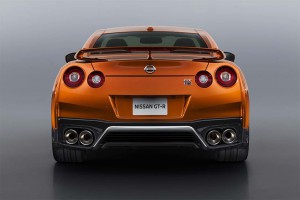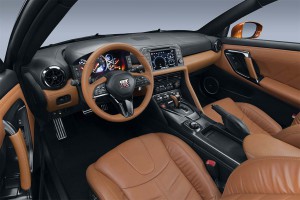The Nissan GT-R is a perpetual motion machine, always seeming to be on the move, even when parked.
Wherever it’s going, it will get there a little faster next year, the Japanese maker giving the little supercar more power – and some design tweaks for 2017. It’s a welcome send-off considering the GT-R is expected to undergo a complete makeover within the next two years.
“As the icon of Nissan’s driving performance, the GT-R continues to evolve,” said Mamoru Aoki, executive design director, Global Design Center, Nissan Motor Co., Ltd. “With the signature V-motion grille, the GT-R now possesses the latest Nissan design language. Its exceptional aerodynamic performance and upgraded interior have given the GT-R a more mature character, which will continue into the future.”
For performance fans, the biggest news coming out of the New York Auto Show is likely to be the upgrades to the GT-R’s twin-turbocharged 3.8-liter V-6 which will now deliver 565 horsepower 467 lb-ft of torque, representing an increase of 20 HP and 4 lb-ft, respectively, from last year’s model. Credit individual ignition-timing control of the cylinders and extra boost from the turbochargers.
(Twenty automakers commit to make emergency auto braking standard by 2022. For more, Click Here.)
The engine will continue to be paired with a six-speed dual-clutch gearbox, but Nissan claims it has smoothed shifts while reducing transmission noise. On the other hand a new lightweight titanium exhaust system and Active Sound Enhancement is designed to enhance the car’s throaty roar, especially during hard acceleration.
Another change, Nissan notes, is the fact that, “the shift paddles are now mounted to the new steering wheel, allowing drivers to change gears in mid-turn without having to take their hands off the wheel.”
From an exterior perspective, the 2017 Nissan GT-R retains its familiar shape, though there’s that new V-Motion grille, and the side sills have been pushed out to improve air flow. Indeed, most of the revisions – such as new functional side air vents — have been designed specifically to improve aerodynamics.
Inside, beyond the relocated shift paddles, the 2017 GT-R gets an all-new instrument panel wrapped in a single, seamless piece of Nappa leather. The IP now adopts a so-called “horizontal flow” layout. To make it easier for a driver to focus on the road, navigation and audio controls have been integrated, reducing the number of switches from 27 to just 11. There’s also a larger, 8-inch touchscreen display.
While the 2017 version of the GT-R brings some welcome enhancements, word has it that an all-new version of the sports car will come as early as 2018. And it’s expected to yield a much more dramatic transition in its design and powertrain.
(Mercedes teaming up with Nissan on luxury pickup. Click Here for the story.)
For one thing, the next model will likely pick up many of the design cues first seen in virtual form with Nissan’s 2020 Vision Gran Turismo Concept.
Under the hood, it may pick up a more advanced, electrified powertrain, though it’s unlikely to go to the extremes we’ve seen with either the BMW i8 or the new Acura NSX which uses a combination of three electric motors and a twin-turbo V-6.
How far Nissan will go is uncertain as it appears certain to remain focused on delivering supercar performance at a relatively mainstream price.
(Infiniti debuting QX70 Limited at NY Auto Show. Click Here for a first look.)




